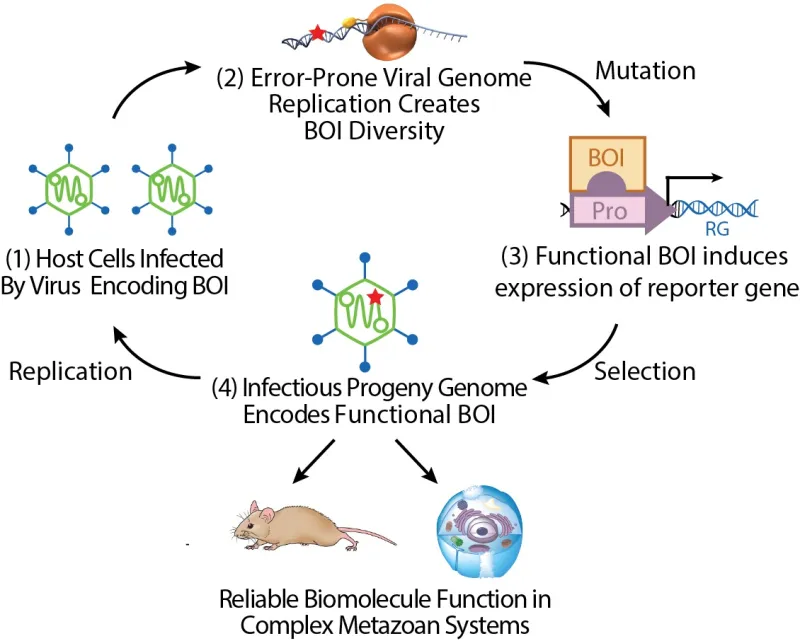A Platform for Continuous Directed Evolution in Human Cells
This invention is a novel system for performing directed evolution in a human cell based system. It has wide-ranging applications in the development of protein-based therapeutics and in evolutionary biology research.
Researchers
-
methods and compositions for performing continuous directed evolution
United States of America | Granted | 11,414,677
Figures
Technology
Human cells replicate slowly with low mutational burden, making it challenging to design evolutionary schemes. Additionally, accelerating overall mutation rate with chemical or genetic mutagens often results in “cheating” in which mutations arise in other compensatory pathways to allow subvert selection, rather than mutating the gene of interest (GOI). These inventors engineered a safe, robust, adenovirus system to circumvent these challenges of human cells. The inventors engineered an adenoviral polymerase (EP-Pol), which replicates only the adenoviral genome, to introduce random mutation at a rate several orders of magnitude greater than wild type adenoviral polymerase. To prevent self-mutation of EP-Pol back to a more efficient state, EP-Pol is expressed in trans in human HEK293 derived cells, and the wild type Pol is deleted from the adenoviral genome. The GOI is then expressed in the adenoviral genome, allowing rapid generation of mutational libraries through adenoviral replication. For a selection scheme, the inventors use the viral protease gene that is required for efficient viral production. The viral protease gene is expressed in trans under the control of an inducible promoter transcriptionally coupled to GOI function. When the GOI has mutations that give more target functionality, it is able to activate the expression of a protease and propagate, while those that lack the correct function are lost. The GOI is therefore repeatedly and continuously selected for new mutations that yield increased target functionality. As a proof of principle experiment, the inventors used this scheme to select for mutations in the tetracycline transactivator protein to be insensitive to doxyclycline induction, and they were able to successfully evolve this functionality in <5 viral generations. Importantly, this system could be rapidly translated to other proteins of interest, allowing evolution of novel protein therapeutics.
Problem Addressed
Biomolecules can have immense potential as therapeutics and research tools. Unfortunately, rational design of proteins is nearly impossible due to the complex structures required for protein function, so scientists have long been limited to utilizing proteins that are found in nature. To surmount this difficulty, genetic engineers have recently taken inspiration from nature and developed technologies that rapidly evolve proteins to have novel functions. However, it remains challenging to develop therapeutics using protein evolution because, until now, no mammalian-optimized directed evolution systems have been created. These inventors have engineered the first broadly generalizable platform for performing directed evolution in human cells that allows rapid protein evolution in a therapeutically relevant system.
Advantages
- First ever broadly generalizable directed evolution platform in living human cells
- Rapidly generates large mutational library through adenoviral replication
- Continuous mutation and selection scheme engineered to reduce selection subversion
License this technology
Interested in this technology? Connect with our experienced licensing team to initiate the process.
Sign up for technology updates
Sign up now to receive the latest updates on cutting-edge technologies and innovations.
